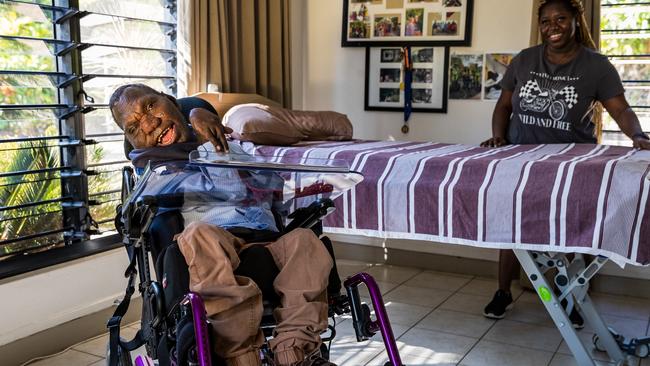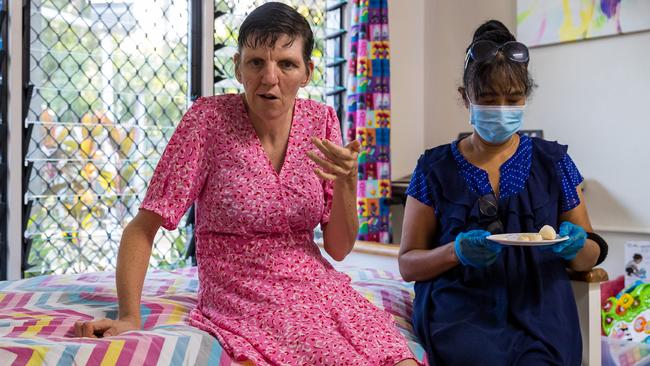NDIS cuts ‘risk health and safety’ of nation’s most severely disabled people
Unjustified NDIS cost cuts targeting the nation’s most severely disabled people are putting their health and safety at risk, disability service providers have warned.

Unjustified NDIS cost cuts targeting the nation’s most severely disabled people are putting their health and safety at risk, disability service providers have warned.
A nationwide study of organisations offering supported independent living (SIL) services to people with profound disabilities found two in three operated at a loss last financial year, leaving providers to choose between funding their client’s support themselves or risking their safety.
The previously unpublished survey of service providers to more than 7000 SIL clients, almost 30 per cent of the national total, found despite receiving average SIL revenues of more than $272,500 per year per client, the average cost of service provision was $279,500, a 2.3 per cent net loss.
Sixteen of the 24 large providers ran at a loss providing essential daily living support for people with the most complex needs, including personal care, feeding and bathing, the PwC report finds.
The funding shortfall was being driven by a targeted program of cuts to SIL packages by the National Disability Insurance Agency even when the NDIS participant’s circumstances hadn’t changed, providers say.
Lawson Broad, the chief executive of Northern Territory SIL service provider Somerville Community Services, said 85 per cent of his organisation’s clients who had a plan review in the past year had received an average cut to services of 8 per cent, but for some, it was more than 25 per cent.
“This funding pays for disability support workers to provide assistance with tasks required for everyday living, so when we see cuts of this size, the only way we can reduce costs is to reduce the hours of support,” Mr Broad said.
“This creates an unsustainable risk to basic health and safety and has a direct impact on some of the most vulnerable people in our community and their ability to live a full life.
“The cuts are often irrational and unsubstantiated; they contradict specialist advice and are so uniform in their application it is hard to see them as anything more than a calculated effort to save money.”
An NDIA spokesperson said there was “no directive to cut the funding packages of NDIS participant plans”.
“It would be incorrect to suggest a participant’s NDIS funding might be reduced without reason. The agency continues to make decisions in accordance with the NDIS Act. Individual plans may go up or down – that is how the scheme is designed,” the spokesperson said.
The NDIS has bipartisan political support, but its financial sustainability has been under increasing scrutiny. The $30bn-a-year cost of the scheme, already outstripping Medicare, is projected to grow to $60bn by the end of the decade. By that time, the current 518,000 recipients of NDIS packages are anticipated to grow to 860,000.
The 26,600 SIL participants are a costly element of the scheme, receiving payments of $8.5bn in the past year.
NDIS SIL recipient Fabian Bush, 55, has been a Somerville client for much of his adult life. The Tiwi Islander has cerebral palsy and epilepsy, among other conditions. He is quadriplegic, non-verbal and feeds via a tube. But he is alert and can communicate through sounds and gestures, such as choosing movies or expressing yes and no.
“He’s a very sociable person,” carer Rosary Muller said. “He likes jokes.”
An occupational therapist assessed Mr Bush as needing 73 hours of two-on-one care and 37 hours of one-on-one care per week, but the NDIS funded him for less than one-fifth of that. His package includes 6.3 hours per week of community access but does not cover visiting the Tiwi Islands to see his family, which would involve charter flights and round-the-clock care.
Mr Bush’s plan was cut 11 per cent in 2021-22 from $318,552 to $283,296. For the time being, Somerville is covering the difference. His guardian, Damian Hale, says the family “wants … Bushy to have the best life he possibly can”.
“The fact that he has gotten to (the age of) 55 is a real tribute to Somerville and the doctors at Royal Darwin Hospital,” he said.
“We are grateful for that, but it’s worrying when we see that the plans have been cut. The only way they can bridge the gap is through fewer staff.”
The PwC research was commissioned last year by provider advocacy groups Alliance20 and Ability First to test the NDIA’s public claim in 2020 that the rapid escalation in SIL costs, put at 17 per cent annually at the time, was not sustainable.
Those surveyed reported an average 9.76 per cent increase in funding in 2020, falling to just 2.75 per cent in 2021. This compared to an average rise in SIL costs of 17.8 per cent in 2020 and 7.35 per cent last year.
Rob White, chief executive officer of the Cerebral Palsy Alliance and spokesman for Alliance20, said SIL plans were being targeted by the NDIA to put a cap on overall NDIS costs.
“It seems to be across the board. It’s downward pressure … to keep SIL packages reduced or reduce the sign-up,” he said.
“These are often the people who have the highest sort of disability. They often need 24-hour support, and assistance with everyday things like eating, showering, bathing and personal care.”
Mr Broad agreed the SIL clients were being targeted by the NDIA due to the high costs of their support. “It’s a perverse approach that is cynical and mean,” he said.

Rebecca Baddeley, 43, another Somerville NDIS client, has an intellectual disability. Her most recent SIL assessment resulted in a 26 per cent reduction in funding, from $4963 a week ($258,076 a year) and reduced to $3633 a week ($188,916 a year).
Hamish Baddeley, Rebecca’s guardian, says the NDIS “has been a positive thing for Rebecca and has provided her with a range of additional supports not previously available”. “However, more recently, we have seen significant cuts to her funding that have caused us real concern about the impact it is likely to have on her care,” he said.
“We can’t understand the logic behind this decision. Rebecca has a permanent disability, and there is nothing about her circumstances that have changed; and yet a decision has been made that she requires less support today than she did a year ago.”
The NDIA said spending on SIL had risen from $3.5bn to $8.5bn over the past three years, a 34 per cent annual rise.
“As of 31 March 2021, the average payment per participant living in SIL was $327,900 – up from $230,200 in 2019,” an NDIA spokesman said.
But Mr White believes part of the reason the NDIA’s total spending on SIL has risen is that a large cohort of complex cases transferred onto the NDIS from state care.
“We don’t want to go back to a system where the support going to people is worse than what they had under the old state-based disability service systems,” he said. “That’s where we’re heading towards.”







To join the conversation, please log in. Don't have an account? Register
Join the conversation, you are commenting as Logout